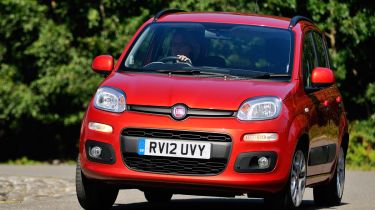Fiat Panda TwinAir
Cute looks and fun factor will win many fans
Make no mistake: we love the Fiat Panda. When fitted with the excellent TwinAir engine, it’s one of the most entertaining city cars money can buy. It also looks great and boasts a stylish interior. But it’s hard to look past its high price, lack of kit and less relaxing driving experience. Factor in its greater fuel consumption and the Panda has to finish in second.
If there’s one company that knows a thing or two about chic city cars, then it’s Fiat. It’s been building brilliant small cars for decades – and the new Panda is no exception, particularly when fitted with the excellent two-cylinder TwinAir engine.
The novel turbocharged motor delivers sub-100g/km CO2 figures, and claimed fuel economy of nearly 70mpg, but also promises a surprising turn of speed. However, the TwinAir Panda Lounge model we tested is £880 more than the Skoda, at £11,250. So is it worth the extra outlay?
To our eyes the Panda certainly looks more distinctive than the Skoda Citigo. The Fiat’s upright design and bold details give it cheeky appeal, while the Lounge has standard 15-inch alloys, front foglights and integrated roof rails.
The Fiat also has the Skoda beaten for style inside. There’s a rounded-square theme in the cabin, so everything, from the gearlever to the stereo speaker grilles, shares the same shape. Other neat touches include the colourful seat-trim pattern and the multiple Panda logos embossed in the door trims.
Used - available now

2023 Kia
Sportage
26,478 milesAutomaticPetrol1.6L
Cash £26,497
2022 Nissan
Qashqai
36,002 milesAutomaticPetrol1.3L
Cash £16,697
2023 Audi
e-tron Sportback
26,067 milesAutomaticElectric
Cash £26,676
2023 Mercedes
EQC
13,012 milesAutomaticElectric
Cash £29,600Sadly, the Fiat can’t match the Citigo for quality. Fit and finish are much better than in the old car, but some plastics look and feel a little low-rent and the switchgear doesn’t move with the same precision as the Skoda’s.
The Panda also trails on standard kit. You get air-con and remote central locking, but that’s about it. You’ll have to pay £505 extra for sat-nav, Bluetooth and a leather steering wheel – all standard on the Skoda. Even a height adjustable driver’s seat is £50, and then the Panda’s driving position still isn’t as comfortable as the Citigo’s.
Passengers in the back also get slightly less legroom than in the Skoda, while a split-fold rear bench is a £50 option. But with the seats in place, the Panda can swallow 225 litres of luggage – only 26 litres less than its rival – and the cabin is stuffed with useful storage.
All thoughts of practicality will be blown away when you twist the key in the ignition. The 875cc engine is a gem, with sparkling performance and a brilliant, thrummy soundtrack. It was dominant at the test track, too, dispatching the fifth-gear 50-70mph sprint in only 10.7 seconds – a full five seconds faster than the Skoda.
On the road, the Panda feels even quicker. Good mid-range torque allows you to nip through crowded city streets and easily keep up with fast-flowing motorway traffic. And while the car is not as composed as the Skoda in corners, direct steering and decent grip mean it’s a lot of fun. It rides well, too, shrugging off most bumps and potholes.
Yet it lacks its rival’s refinement. The Panda has to give best to the Skoda in the financial stakes, though. Not only is it more expensive to buy, but our 40.6mpg test figure suggests it also costs more to run. Poorer residuals and a less comprehensive tally of kit further weaken the Panda’s case.







